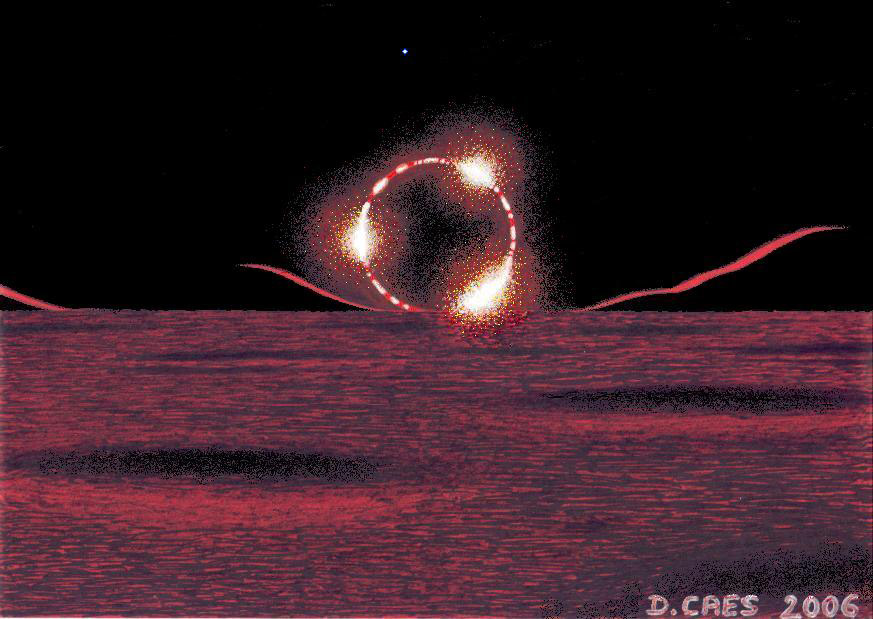Difference between revisions of "January 17, 2010"
| Line 1: | Line 1: | ||
__NOTOC__ | __NOTOC__ | ||
=Eclipse From the Moon= | =Eclipse From the Moon= | ||
| − | |||
<!-- ws:start:WikiTextHeadingRule:1:<h1> --> | <!-- ws:start:WikiTextHeadingRule:1:<h1> --> | ||
<!-- ws:start:WikiTextLocalImageRule:16:<img src="/file/view/LPOD-Jan17-10.jpg/113917143/LPOD-Jan17-10.jpg" alt="" title="" /> -->[[File:LPOD-Jan17-10.jpg|LPOD-Jan17-10.jpg]]<!-- ws:end:WikiTextLocalImageRule:16 --><br /> | <!-- ws:start:WikiTextLocalImageRule:16:<img src="/file/view/LPOD-Jan17-10.jpg/113917143/LPOD-Jan17-10.jpg" alt="" title="" /> -->[[File:LPOD-Jan17-10.jpg|LPOD-Jan17-10.jpg]]<!-- ws:end:WikiTextLocalImageRule:16 --><br /> | ||
| − | <em>image by [mailto:danny.caes1@pandora.be Danny Caes], Belgium</em><br /> | + | <em>image by [mailto:danny.caes1@pandora.be" rel="nofollow Danny Caes], Belgium</em><br /> |
<br /> | <br /> | ||
This drawing shows a total solar eclipse (by Earth) as it should be observed from a region near the moon's limb. The Earth's silhouetted orb is "touching" the moon's horizon, and the refracted light of the sun is seen as three bright elongated (and curved) dots. All around the circle of Earth's atmosphere one could see bright and not-so-bright spots of refracted sunlight. The moon's surface is typically red-colored, and a contrasting bluish-colored planet Venus is noticeable above Earth's red-colored ring.<br /> | This drawing shows a total solar eclipse (by Earth) as it should be observed from a region near the moon's limb. The Earth's silhouetted orb is "touching" the moon's horizon, and the refracted light of the sun is seen as three bright elongated (and curved) dots. All around the circle of Earth's atmosphere one could see bright and not-so-bright spots of refracted sunlight. The moon's surface is typically red-colored, and a contrasting bluish-colored planet Venus is noticeable above Earth's red-colored ring.<br /> | ||
This drawing was made on a piece of red paper. The black space was "painted" with black marker. The bright spots of refracted sunlight with white and yellow marker. The lunar surface with common grey pencil. To add much more contrast in the scan of this drawing, I enhanced the blackness of space (and the shadowed parts of the craters) via the PAINT-program.<br /> | This drawing was made on a piece of red paper. The black space was "painted" with black marker. The bright spots of refracted sunlight with white and yellow marker. The lunar surface with common grey pencil. To add much more contrast in the scan of this drawing, I enhanced the blackness of space (and the shadowed parts of the craters) via the PAINT-program.<br /> | ||
<br /> | <br /> | ||
| − | <em>[mailto:danny.caes1@pandora.be Danny Caes]</em><br /> | + | <em>[mailto:danny.caes1@pandora.be" rel="nofollow Danny Caes]</em><br /> |
<br /> | <br /> | ||
<strong>Related Links</strong><br /> | <strong>Related Links</strong><br /> | ||
| − | [http://apod.nasa.gov/apod/ap070302.html Another view]<br /> | + | [http://apod.nasa.gov/apod/ap070302.html" rel="nofollow Another view]<br /> |
<br /> | <br /> | ||
<hr /> | <hr /> | ||
Revision as of 19:17, 4 January 2015
Eclipse From the Moon

image by " rel="nofollow Danny Caes, Belgium
This drawing shows a total solar eclipse (by Earth) as it should be observed from a region near the moon's limb. The Earth's silhouetted orb is "touching" the moon's horizon, and the refracted light of the sun is seen as three bright elongated (and curved) dots. All around the circle of Earth's atmosphere one could see bright and not-so-bright spots of refracted sunlight. The moon's surface is typically red-colored, and a contrasting bluish-colored planet Venus is noticeable above Earth's red-colored ring.
This drawing was made on a piece of red paper. The black space was "painted" with black marker. The bright spots of refracted sunlight with white and yellow marker. The lunar surface with common grey pencil. To add much more contrast in the scan of this drawing, I enhanced the blackness of space (and the shadowed parts of the craters) via the PAINT-program.
" rel="nofollow Danny Caes
Related Links
" rel="nofollow Another view



